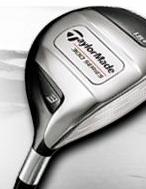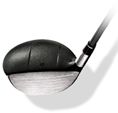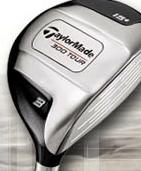product review  Taylor Made Taylor Made
300 Series Fairway Woods:
Bucking The Trends
By Jeffrey A. Rendall, TravelGolf.com Senior Writer
Pop culture’s strange sometimes. Every so often, a new consumer product hits the shelves and people go wild—then runs its course, and fades into oblivion. Think about it—when was the last time you saw a Rubic’s cube? A Betamax machine? A Polaroid instant camera? There’s usually a good reason why such a product causes a new sensation—it’s something new and different, gives performance that was previously unheard of, and bills itself as the wave of the future. Inevitably some other manufacturer comes along with something newer and better--the future then becomes the present. Hence, we now have computer games, videodisk players and digital cameras to replace the Rubic’s cube, the Betamax machine (and, eventually VCR’s) and the Polaroid instant camera. Not too long ago, a similar consumer sensation hit the golf manufacturing world—well, actually several sensations. Persimmon drivers changed to metal, and got larger; irons became cavity backed and oversized; and putter heads doubled in height and width (remember Jack’s putter at the Masters?). Everything got bigger, all of a sudden. Except for one thing—fairway woods. Somehow, those ‘gap’ clubs between your long irons and driver seemed to fall off the bandwagon, getting smaller in face and profile while also becoming easier to hit. Didn’t really make sense. Most club manufacturers were telling us to buy huge
drivers and larger irons because they inject more ‘confidence,’ while many of the same club makers were telling us to purchase smaller faced fairway woods because they’re ‘easier to hit.’ Huh?  Now, however, rationality’s on our side. Some of those low profiled jobs weren’t quite so hot in certain situations, and the pendulum’s swinging back in the other direction. Size does matter! But not just bigger—players demanded a larger clubface to increase playability, while simultaneously retaining the increased utility of the older low profile clubs. Now, however, rationality’s on our side. Some of those low profiled jobs weren’t quite so hot in certain situations, and the pendulum’s swinging back in the other direction. Size does matter! But not just bigger—players demanded a larger clubface to increase playability, while simultaneously retaining the increased utility of the older low profile clubs.
I should know, because I’m such a player, and I was demanding something more. I think I’ve found it in the Taylor Made 300 Series Fairway Woods. To be honest, fairway woods have always scared me to death. There had to be some reason why I could hit everything in my bag off the deck except for woods (and my two-iron). Forget counting the driver—for average players, that’s strictly a teeing club. I’ve been stunned at how club fitters actually recommend that average golfers use more fairway woods—I thought all that’d mean for me was sculled fairway shots and hundred yard worm burners. But a lot of my playing partners swore by the new clubs. As a result, I tried some of the new low-profile fairway woods and finally found out I could get the ball off the ground. There were some situations, however, where the small head wasn’t such a benefit. If I wanted something less than a driver on any given hole, teeing off with those skinny faces meant I had to tee the ball really low to ensure good contact—and I didn’t always get that. Finally, if I ever thought of using a utility wood out of rough, the clubs had a tendency to dip under the ball, causing a weak little pop fly to shortstop. Something needed to be done.  That’s where Taylor Made’s new line comes in. Tom Olsavsky designed the Taylor Made 300 Series Fairway Metals (both the 300 Series and the 300 Tour), and he says my experiences were typical—they’re the reasons why Taylor Made created a whole new line to combat the usual problems. That’s where Taylor Made’s new line comes in. Tom Olsavsky designed the Taylor Made 300 Series Fairway Metals (both the 300 Series and the 300 Tour), and he says my experiences were typical—they’re the reasons why Taylor Made created a whole new line to combat the usual problems.
“There’ve been a lot of good fairway woods designed over the years, but we’re trying to take them to the next level. Average players raved about how the shallow faced fairway woods were incredible off the short grass, but the performance slipped some off the tee and in the rough. Therefore, we’ve created fairway metals with a slightly larger face, while keeping the lower center of gravity that the shallow faced clubs featured.” “In order to do that, we’ve substituted lighter metals—titanium and tungsten—for steel. The switch allowed us to increase the size of the head somewhat, giving the club a little more playability while retaining the benefits of the shallow faced fairway metals, which is the lower COG.” Geez—the terminology brings me back to eleventh grade physics class—and reinforces my decision to major in political science in college. But the math works—and because of it, the TM 300 Series fairway woods give average players even more options than their shallow faced predecessors. The fairway series compliments the 300 Series Driver I tested out (the 320 Ti), and now I believe I have the right clubs to replace my old two-iron and 3-wood. The 300 Series’ sibling, the 300 Tour Fairway Metals—are also designed to increase performance over the older genre of shallow faced clubs—and incorporate many of the workability features found in the 300 Ti driver. I tried the 300 Series because of its design features for the average player—a little higher ball flight and slight offset. You’ll never mistake my swing for Ernie Els’ or Tom Lehman’s—two of the many PGA pros who favor the more advanced Taylor Made Tour line (though Olsavsky says it’s only about a 60-40 split amongst professionals for those who prefer the Tour model over the Series).
I asked Olsavsky why fairway woods weren’t going the way of other clubs—in terms of oversize and the like. He responded, “unlike drivers, where you can tee the ball up, fairway woods are often used off the ground—and for those situations, more size doesn’t necessarily bring more performance. Sure, you want enough face area to play off both the tee and from the fairway, but there’s got to be a happy median somewhere.” “We actually tried out a larger version of a fairway metal to compliment our 360 Ti model driver, but found it didn’t really work, and people didn’t want it. So, when we got increased performance with the Series and the Tour models, we didn’t find it necessary to force a larger head on a fairway metal.” Taking it out on the course, I looked for increased performance from the clubs over my previous models—the aforementioned two-iron and low profile 3-wood. I tried a TM 15 degree 3-wood and a 17 degree 5-wood. First off, the 5-wood was a HUGE improvement over my old two-iron. Here’s where the club fitters are right—just the looks of the 5-wood brought more confidence at address. I’ve always had real difficulty with the two-iron, because I often toe’d the ball, resulting in a weak slice with little distance—or hit a thin ground ball. It got to the point where I didn’t even use it anymore, because the chances of success were so low.  The 5-wood broke that trend right away. Getting it in the air’s a cinch, and if anything, I had trouble because I hit it TOO far. I was looking for getting 215 yards or so off the tee with it, and it went closer to 230 yards . The only problem I note with it is—I tend to pull it left because of the offset. I correct the problem by playing it slightly farther back in my stance. The 5-wood broke that trend right away. Getting it in the air’s a cinch, and if anything, I had trouble because I hit it TOO far. I was looking for getting 215 yards or so off the tee with it, and it went closer to 230 yards . The only problem I note with it is—I tend to pull it left because of the offset. I correct the problem by playing it slightly farther back in my stance.
My results with the 3-wood weren’t quite as stellar, but still an improvement over my previous club—especially off the tee. The slightly bigger face made for more solid and consistent contact. Off the fairway, I still tended to hit low line drives—but I attribute that to my mental block more than any failings in the club. When I did connect, it was nothing but solid sweet feel and excellent distance. Pure promise there. I look forward to getting in some solid practice time using these clubs—and the results I’ve seen make me a believer that better days are ahead for my long game off the turf. I think it’ll prove that Taylor Made’s new 300 Series fairway woods will not go the way of the Betamax machine—because they’re bucking the trend
already. The Taylor Made 300 Series/Tour Fairway Woods
Club Designer: Tom Olsavsky
Available at fine Pro Shops and Golf Retail Stores Check out all of Taylor Made's outstanding products at
http://www.taylormadegolf.com
|
 The 5-wood broke that trend right away. Getting it in the air’s a cinch, and if anything, I had trouble because I hit it TOO far. I was looking for getting 215 yards or so off the tee with it, and it went closer to 230 yards . The only problem I note with it is—I tend to pull it left because of the offset. I correct the problem by playing it slightly farther back in my stance.
The 5-wood broke that trend right away. Getting it in the air’s a cinch, and if anything, I had trouble because I hit it TOO far. I was looking for getting 215 yards or so off the tee with it, and it went closer to 230 yards . The only problem I note with it is—I tend to pull it left because of the offset. I correct the problem by playing it slightly farther back in my stance.  Taylor Made
Taylor Made  Now, however, rationality’s on our side. Some of those low profiled jobs weren’t quite so hot in certain situations, and the pendulum’s swinging back in the other direction. Size does matter! But not just bigger—players demanded a larger clubface to increase playability, while simultaneously retaining the increased utility of the older low profile clubs.
Now, however, rationality’s on our side. Some of those low profiled jobs weren’t quite so hot in certain situations, and the pendulum’s swinging back in the other direction. Size does matter! But not just bigger—players demanded a larger clubface to increase playability, while simultaneously retaining the increased utility of the older low profile clubs.  That’s where Taylor Made’s new line comes in. Tom Olsavsky designed the Taylor Made 300 Series Fairway Metals (both the 300 Series and the 300 Tour), and he says my experiences were typical—they’re the reasons why Taylor Made created a whole new line to combat the usual problems.
That’s where Taylor Made’s new line comes in. Tom Olsavsky designed the Taylor Made 300 Series Fairway Metals (both the 300 Series and the 300 Tour), and he says my experiences were typical—they’re the reasons why Taylor Made created a whole new line to combat the usual problems.